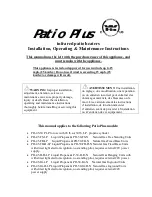
58
seQuence of operation
read the Sequence of Operation below before attempting to
correct any operational problems. refer to the Features And
Components section beginning on page 7 for the location
of various water heater components described below. See the
Sequence Of Operation Flow Chart on page 59 also.
1. When the control system is first powered, during boot
up, it will display water heater model information during
initialization. After a few moments the control system LCD
which is part of the UIm (user interface module) will display
the default screen known as the "Desktop" screen.
2. If the control system determines that the actual water
temperature inside the tank is below the programmed
Operating Set Point minus the Differential setting, a heating
cycle is activated.
3. The control system then performs selected diagnostic system
checks. This includes confirming the low gas pressure,
blocked exhaust, blocked intake and ECO (energy cut
out) switch contacts are closed. The Blower Prover Switch
contacts are confirmed open.
4. If all diagnostic checks are successfully passed, the control
system energizes the Combustion Blower for pre-purge.
5. The control system must confirm the Blower Prover Switch
contacts close after the Combustion Blower is energized.
6. If the Blower Prover Switch contacts are confirmed closed
the control system energizes the Hot Surface Igniter for the
igniter warm-up period.
7. The control system monitors the igniter current and must
sense a minimum of 2.0 AC amps during the igniter warm up
period (12-17 seconds).
8. If igniter amperage is confirmed at or above the required
minimum the control system energizes the 24 Volt Gas Valve
allowing gas to flow to the main Burner.
9. The control system de-energizes the Hot Surface Igniter.
10. The control system monitors the flame sensor to confirm a
flame is present at the main Burner. If a flame is not verified
during the ignition trial period the control system will try for
ignition up to two more times. If flame can not be verified after
three trials for ignition, the control system will lock out and
display the “Ignition Failure” Fault message.
11. If a flame is verified, the control system will enter the
heating mode where it will continue heating the water until
the Operating Set Point is reached. At this point, the control
system will de-energize the 24 Volt Gas Valve and enter the
post-purge cycle (approximately 30 seconds).
12. The Combustion Blower will run for the duration of the post-
purge cycle to purge the water heater of all combustion
gases. When the post-purge cycle is complete, the blower is
de-energized and will coast to a stop.
13. The control system now enters the standby mode while
continuing to monitor the internal storage tank water
temperature and the state of other system devices. If the
tank temperature drops below the Operating Set Point minus
the Differential setting, the control will automatically return to
Step 2 and repeat the operating cycle.
trouBleshooting
installation checklist
The list below represents some of the most critical installation
requirements that, when overlooked, often result in operational
problems, down time and needless parts replacement. This
is not a complete list. Before performing any troubleshooting
procedures use the list below to check for installation errors.
Costs to correct installation errors are not covered under the
limited warranty. Ensure all installation requirements and
instructions in this manual have been maintained and followed.
water heater location
1. Ensure proper clearances to combustibles are maintained
and there is sufficient room to service the water heater. See
Clearance To Combustible materials on page 13.
2. Ensure the area is free of corrosive elements and flammable
materials. See the instructions on page17.
Venting
3. Ensure the intake air and/or vent (exhaust) piping is the correct
size for the installed length. See Venting requirements on
page 24.
4. Ensure the maximum equivalent feet of pipe has not been
exceeded for the intake air and/or vent pipe. See Table 7 on
page 24.
5. Ensure the maximum number of elbows has not been
exceeded in the intake air and/or vent pipe. See Venting
requirements on page 24.
6. Ensure the intake air screen has been removed from the
intake air connection on the water heater when installing the
water heater in a Direct Vent configuration. See Figure 19
on page 26.
7. Ensure all exterior clearances for the intake air, vent and
concentric terminations are maintained. See Vertical
Termination Installation on page 27, Sidewall Termination
Installation on page 29 and Concentric Termination Installation
on page 30. These clearances and those cited by local and
national codes must be maintained.
gas supply and piping
8. Ensure a supply gas regulator has been installed for each
water heater. See the requirements for a Supply Gas regulator
on page 14 and Supply Gas regulator on page 14.
9. Ensure the supply gas line to each water heater meets
the minimum supply gas line size requirements. See the
requirements for the Gas Supply Systems on page 14 and
the installation instructions on page 39 and 40.
condensate drain
10. Ensure the condensate drain is properly connected to the
exhaust elbow on the water heater and draining freely to a
suitable floor drain. See Figure 9 on page 17 and Condensate
Drain Installation on page 38.
electrical connections
11. Ensure the power supply connections to the water heater are
polarity correct. See the requirements for the Power Supply
on page 14 and Electrical Wiring on page 41.
12. Ensure the water heater is properly grounded. Flame sensing
requires an adequate earth ground. If the water heater is not
properly grounded it will cause Ignition Failure.
















































